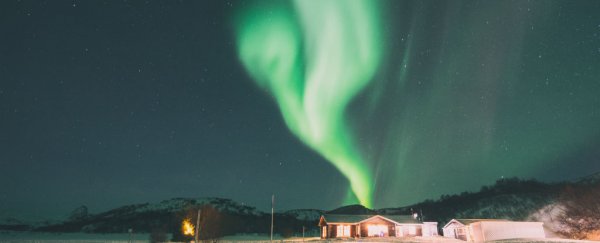As beautiful as they are, the aurora borealis in the Northern Hemisphere and the aurora australis in the south are known to wreak havoc on our satellite-based global positioning systems, and until now, everyone assumed it was the result of plasma turbulence within these disruptive light shows.
But there's a big problem with that explanation - for the first time, scientists have shown that turbulence doesn't actually exist in the northern lights, which means an unknown mechanism is responsible for the historic blackouts and strange outages in our GPS signals.
"It remains to be understood exactly what physical mechanism is the cause of these observations," researchers from the University of Bath in the UK conclude.
"Hence, more measurements and new theory are necessary to understand this issue."
Aurorae occur during solar storms, when electrically charged particles emitted by the Sun excite gas particles in Earth's upper atmosphere, at an altitude of around 300 km (185 miles).
This causes the molecules in our atmosphere to release light particles - or photons - resulting in the bright bursts of light that can sometimes make patterns along Earth's magnetic field lines.
But there's another big effect of this interaction between solar particles and atmospheric particles - or so we thought.
There's a layer in Earth's upper atmosphere called the ionosphere, which is a vast shell of charged particles that our planet has built up as a result of being constantly blasted by solar particles for billions of years.
If it remains consistent, this shell of plasma (or ionised gas) can be used to 'bounce' a transmitted signal from space down to Earth.
That's how the Global Navigation Satellite Systems (GNSS) signals that inform our GPS devices actually work - a constellation of satellites orbiting Earth at an altitude of 20,000 km communicate with a network of receivers on the ground to figure out where you are.
But during solar storms, where abnormally massive bursts of charged particles from the Sun are fired at Earth, the balance of the plasma ionosphere gets disturbed.
It's long been thought that this turbulence is to blame for the historic, widespread blackouts experienced during severe solar storms, plus major satellite disturbance and malfunctions in GPS-based navigation.
As NASA explained back in 2015:
"If you think of the ionosphere as a fluid, the irregularities comprise regions of lower density (bubbles) in the neighbourhood of high-density ionisation areas, creating the effect of clumps of more and less intense ionisation.
This 'froth' can interfere with radio signals including those from GPS and aircraft, particularly at high latitudes."
Now, researchers in the UK have tried to investigate the phenomenon of turbulence, only to wind up empty-handed.
Observing the northern lights in the city of Tromsø in northern Norway, they used GNSS signals to identify how the light show interfered with GPS signals in real-time.
As the team explains, GNSS is used to pinpoint the geographic location of a user's receiver anywhere in the world, and systems based on this data include the US's Global Positioning System (GPS), the Russian Federation's Global Orbiting Navigation Satellite System (GLONASS), and Europe's Galileo.
During the northern lights, one group of researchers used radar technology to track the visuals of the aurora, while the other tracked the effects on GPS signals. The idea was to identify the plasma structures that give rise to disturbances on the GPS radio link.
Using something called the intensity scintillation index to measure turbulence in the ionosphere, they were hoping to link the two up, but instead report several instances where GPS glitches occurred while the turbulence index remained eerily stable.
"In general, the intensity scintillation index remained very small and constant throughout all of the measurements," the team reports.
Instead of turbulence, the researchers say the phenomenon has to be down to a "new instability mechanism" that operates in the ionosphere where aurorae appear, but at this point, they have no idea what that could be.
As Andrew Masterson points out at Cosmos, "the Bath researchers' work generated far more questions than answers", but it gives researchers a new avenue to pursue in the hopes of one day being able to predict and prepare for severe solar storms that could cause serious, long-term damage.
"The potential impact of inaccurate GNSS signals could be severe. Whilst outages in mobile phones may not be life threatening, unreliability in satellite navigations systems in autonomous vehicles or drones delivering payloads could result in serious harm to both humans and the environment," says one of the team, Biagio Forte.
"This new understanding of the mechanisms which affect GNSS outages will lead to new technology that will enable safe and reliable satellite navigation."
The research has published in the Journal of Geophysical Research.
